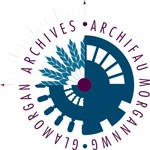The role of the Food Commissioners during the First World War was not an easy one, as the letter book of David Tilley, the Executive Officer of the Cowbridge Food Control Committee for 1917-18, shows. Sugar, meat, tea, butter or margarine were rationed, prices were fixed and retailers had to provide monthly detailed information to the Committee.
In November 1917, David Tilley wrote to the Divisional Commission in Cardiff about the difficulty experienced in enforcing the butter order:
Mr Llewellyn, Morland Farm, Penlline who has supplied butter at many houses in the town for very many years charged 2/3 for his ‘Farm Butter’ in 1lb bricks. This was paid under protest by several of his customers. Yesterday he called upon his customers & told them that he would not supply them this week or until the price was increased. This will cause a great inconvenience to many. He suggested to some of his customers that he would take it to Bridgend, to others that he ‘would put it down’.
Unfortunately it appeared that he received an unhelpful reply and wrote again:
…that there is no remedy against a farmer withholding his butter from his regular customers in consequence of the fixed price… This I think is a great grievance to people and it appears to border on hoarding necessary food.
Other problems are mentioned in David Tilley’s letter book. In a letter to Mrs Thisell of Cowbridge, who had written complaining that Messrs Robert Roberts & Co Bridgend charged her 10/- for a bag of potatoes, he states:
I asked the Bridgend Police to go to their shop & examine their invoices, to find what they paid for the potatoes. I do not think they did this but was told by Mr Roberts that they had paid Mr England, Cardiff £8 5s per ton and carriage for them.
Mr Rees, Darren Farm, had been ordered to plough certain pasture fields:
He has sold milk for 50 years and supplies 250 from his 18 cows. If he must plough he will give up the sale of Milk as the best pasture will be ploughed and he cannot cultivate fields as well as retail milk.
A complaint had been made against D Williams & Sons that they made a condition of sale of margarine that they would not supply it unless the customer held sugar tickets. They were informed that such refusal was illegal and liable to prosecution:
Therefore on this occasion we wish to warm you that should further reliable complaint be made that we will have to proceed against you at law.
Other problems included the Girls School not depositing their coupons with a retail grocer and not registering as a customer with any retailer; also butchers overcharging for underweight meat or not being able to obtain enough meat to sell.
Government Departments had to have explained to them that:
…this district contains very few over 1000 in population but is a centre for shopping for a large area around 4 or 5 or even more miles around.
On one occasion David Tilley wrote:
At least 12 shops used to sell imported butter, five only have made returns, the others have closed down over the difficulties of obtaining foods.
Unfortunately, as with all the letters in the book, we do not have any replies so the outcomes remain a mystery.
Ann Konsbruck, Glamorgan Archives Volunteer




